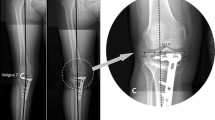Abstract
Purpose
Medial opening wedge high tibial osteotomy (HTO) is a realignment of the lower limb. Despite accurate preoperative planning and careful surgical techniques, many HTOs result in alignment correction errors. These alignment correction errors may be due to soft tissue laxity around the knee such as varus or valgus laxity. The purpose of this study was to examine the relationship of varus and valgus laxity of the knee and alignment correction errors, and to have a formula to predict the subsequent degree of these correction errors.
Materials and methods
Fifty knees from 41 patients undergoing opening wedge HTO for knee osteoarthritis were involved. Standing full-length anteroposterior radiographs of the lower limb and the tibia, and varus and valgus stress radiographs of the knee were used to evaluate alignment and joint laxity. Parameters were global correction (the change in the hip–knee–ankle angle), bony correction (the change in the medial proximal tibial angle), and soft tissue correction (global correction − bony correction).
Results
The average of global correction, bony correction, and soft tissue correction were 12.8° ± 4.3°, 9.4° ± 3.2°, and 3.4° ± 2.5°, respectively. Preoperative varus laxity was moderately correlated with soft tissue correction (R = 0.58), and in which the slope of the line in the scatter plot represented 0.59, implying that soft tissue correction increases by 0.59° for every 1° of preoperative varus laxity.
Conclusions
Preoperative varus laxity is correlated with soft tissue correction, suggesting that more accurate alignment correction could be achieved by surgical planning taking into account preoperative varus laxity as a factor of soft tissue correction.





Similar content being viewed by others
References
Debeyre J (1951) Surgical treatment of arthroses of the knee. Sem Hop 27:2515–2518
Petersen W, Metzlaff S (2016) Open wedge high tibial osteotomy (HTO) versus mobile bearing unicondylar medial joint replacement: 5 years results. Arch Orthop Trauma Surg 136:983–989. doi:10.1007/s00402-016-2465-1
Petersen W, Wall A, Paulin T, Park HU, Heymann L (2014) Stability of two angular stable locking plates for open wedge high tibial osteotomy (HTO): TomoFix™ versus LOQTEQ® HTO plate. Arch Orthop Trauma Surg 134:1437–1442. doi:10.1007/s00402-014-2042-4
Niinimäki T, Eskelinen A, Ohtonen P, Puhto AP, Mann BS, Leppilahti J (2014) Total knee arthroplasty after high tibial osteotomy: a registry-based case-control study of 1036 knees. Arch Orthop Trauma Surg 134:73–77. doi:10.1007/s00402-013-1897-0
Giuseffi SA, Replogle WH, Shelton WR (2015) Opening-wedge high tibial osteotomy: review of 100 consecutive cases. Arthroscopy 31:2128–2137. doi:10.1016/j.arthro.2015.04.097
Kim SJ, Koh YG, Chun YM, Kim YC, Park YS, Sung CH (2009) Medial opening wedge high-tibial osteotomy using a kinematic navigation system versus a conventional method: a 1-year retrospective, comparative study. Knee Surg Sports Traumatol Arthrosc 17:128–134. doi:10.1007/s00167-008-0630-y
Hernigou P, Medevielle D, Debeyre J, Goutallier D (1987) Proximal tibial osteotomy for osteoarthritis with varus deformity. A 10–13-year follow-up study. J Bone Joint Surg Am 69:332–354
Bito H, Takeuchi R, Kumagai K, Aratake M, Saito I, Hayashi R, Sasaki Y, Aota Y, Saito T (2009) A predictive factor for acquiring an ideal lower limb realignment after opening-wedge high tibial osteotomy. Knee Surg Sports Traumatol Arthrosc 17:382–389. doi:10.1007/s00167-008-0706-8
Odenbring S, Egund N, Hagstedt B, Larsson J, Lindstrand A, Toksvig-Larsen S (1991) Ten-year results of tibial osteotomy for medial gonarthrosis. The influence of overcorrection. Arch Orthop Trauma Surg 110:103–108
Miniaci A, Ballmer FT, Ballmer PM, Jakob RP (1989) Proximal tibial osteotomy. A new fixation device. Clin Orthop Relat Res 246:250–259
Lee YS, Kim MG, Byun HW, Kim SB, Kim JG (2013) Reliability of the imaging software in the preoperative planning of the open-wedge high tibial osteotomy. Knee Surg Sports Traumatol Arthrosc. doi:10.1007/s00167-013-2700-z
Lee DC, Byun SJ (2012) High tibial osteotomy. Knee Surg Relat Res 24:61–69. doi:10.5792/ksrr.2012.24.2.61
Gaasbeek RD, Nicolaas L, Rijnberg WJ, van Loon CJ, van Kampen A (2010) Correction accuracy and collateral laxity in open versus closed wedge high tibial osteotomy. A 1-year randomised controlled study. Int Orthop 34:201–207. doi:10.1007/s00264-009-0861-7
Lee DH, Park SC, Park HJ, Han SB (2015) Effect of soft tissue laxity of the knee joint on limb alignment correction in open-wedge high tibial osteotomy. Knee Surg Sports Traumatol Arthrosc. doi:10.1007/s00167-015-3682-9
Fujisawa Y, Masuhara K, Shiomi S (1979) The effect of high tibial osteotomy on osteoarthritis of the knee. An arthroscopic study of 54 knee joints. Orthop Clin North Am 10:585–608
Schröter S, Ihle C, Mueller J, Lobenhoffer P, Stöckle U, van Heerwaarden R (2013) Digital planning of high tibial osteotomy. Interrater reliability by using two different software. Knee Surg Sports Traumatol Arthrosc 21:189–196. doi:10.1007/s00167-012-2114-3
Akamatsu Y, Mitsugi N, Mochida Y, Taki N, Kobayashi H, Takeuchi R, Saito T (2012) Navigated opening wedge high tibial osteotomy improves intraoperative correction angle compared with conventional method. Knee Surg Sports Traumatol Arthrosc 20:586–593. doi:10.1007/s00167-011-1616-8
Gebhard F, Krettek C, Hüfner T, Grützner PA, Stöckle U, Imhoff AB, Lorenz S, Ljungqvist J, Keppler P, CSEG A (2011) Reliability of computer-assisted surgery as an intraoperative ruler in navigated high tibial osteotomy. Arch Orthop Trauma Surg 131:297–302. doi:10.1007/s00402-010-1145-9
Dugdale TW, Noyes FR, Styer D (1992) Preoperative planning for high tibial osteotomy. The effect of lateral tibiofemoral separation and tibiofemoral length. Clin Orthop Relat Res 274:248–264
Author information
Authors and Affiliations
Corresponding author
Ethics declarations
Conflict of interest
There are no conflict of interest to declare.
Rights and permissions
About this article
Cite this article
Ogawa, H., Matsumoto, K., Ogawa, T. et al. Preoperative varus laxity correlates with overcorrection in medial opening wedge high tibial osteotomy. Arch Orthop Trauma Surg 136, 1337–1342 (2016). https://doi.org/10.1007/s00402-016-2521-x
Received:
Published:
Issue Date:
DOI: https://doi.org/10.1007/s00402-016-2521-x




